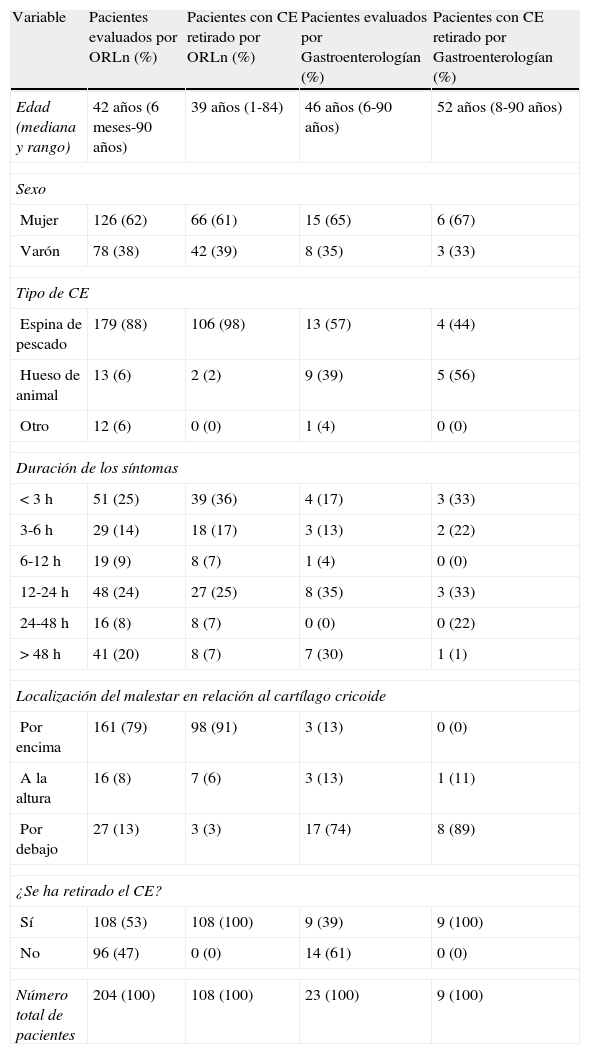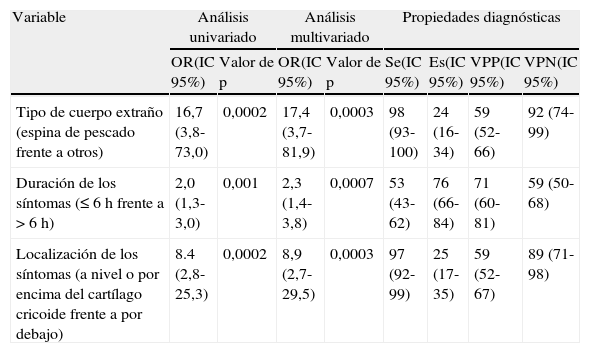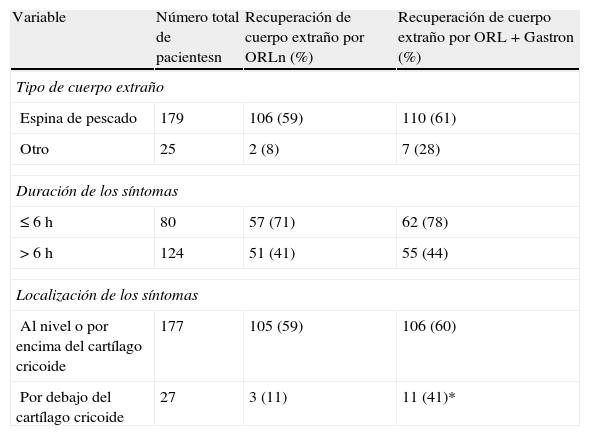Determinar la frecuencia con la que se encuentran cuerpos extraños ingeridos y los factores que pueden predecir su extracción.
MétodosDurante un año estudiamos prospectivamente a todos los pacientes que fueron remitidos a nuestro servicio de Urgencias Otorrinolaringológicas por la ingestión de cuerpos extraños.
ResultadosDurante el estudio admitimos a 204 pacientes (edad media: 42 años [10 meses-84 años]) a causa de la ingestión de cuerpos extraños. El más frecuente fue la espina de pescado (88%). La mayoría de estos pacientes acudieron en las primeras 24h posteriores a la ingestión (72%), y referían síntomas por encima del cartílago cricoides (79%). El cuerpo extraño fue identificado y extraído por ORL en 108 pacientes (53%). Veintitrés pacientes (11%) fueron remitidos a Gastroenterología. En 9 de estos pacientes (39%), el cuerpo extraño fue identificado mediante endoscopia digestiva alta, siempre en el esófago. Las variables predictivas para la extracción por el equipo de ORL fueron la ingesta de espina de pescado (p=0,000; odds ratio [OR]=17,3), la corta duración de los síntomas (<6h) (p=0,001; OR=2,3) y los síntomas por encima o a la altura del cartílago cricoides (p=0,000; OR=8,9). En los pacientes con síntomas por debajo del cartílago cricoides la tasa de retirada del cuerpo extraño por el equipo de ORL (11%) fue significativamente superada por Gastroenterología (41%; p=0,03).
ConclusionesLos pacientes con ingestión de cuerpo extraño, que han ingerido espinas de pescado, y que acuden durante las primeras 6h, o se quejan de síntomas a la altura o por encima del cartílago cricoide, justifican una mayor inversión de tiempo y recursos en cuanto a la extracción de cuerpos extraños ingeridos por el ORL.
To determine how often ingested foreign bodies are found and what parameters may predict their retrieval.
MethodsDuring 1 year, we prospectively studied all patients referred to our Ear Nose and Throat Emergency Unit because of foreign body ingestion.
ResultsDuring the study, 204 (median age-42 years [10 months-84 years]) patients were admitted because of ingested foreign body. The most common was fish bone (88%). Most patients were admitted <24-hour after ingestion (72%) and complained of symptoms above the cricoid cartilage (79%). A foreign body was removed by Ear Nose and Throat team in 108 (53%) patients. Twenty-three (11%) patients were referred to Gastroenterology. In 9 (39%) of these patients, a foreign body was identified by esophagogastroscopy, always from the esophagus. Predictive variables for retrieval of foreign body by Ear Nose and Throat team were ingested fish bone (P=.000; odds ratio [OR]=17.3), short duration (<6hours) of symptoms (P=.001; OR=2.3) and symptoms above or at the level of cricoid cartilage (P=.000; OR=8.9). In patients with symptoms below the cricoid cartilage the rate of retrieval of foreign body by Ear Nose and Throat team (11%) was significantly increased by Gastroenterology (41%; P=.03).
ConclusionsPatients with ingestion of foreign body who ingest fish bone, present within the first 6hours or complain of symptoms at or above cricoid cartilage deserve greater investment in terms of time and resources for retrieval of ingested foreign body by Ear Nose and Throat team.
Artículo
Comprando el artículo el PDF del mismo podrá ser descargado
Precio 19,34 €
Comprar ahora










